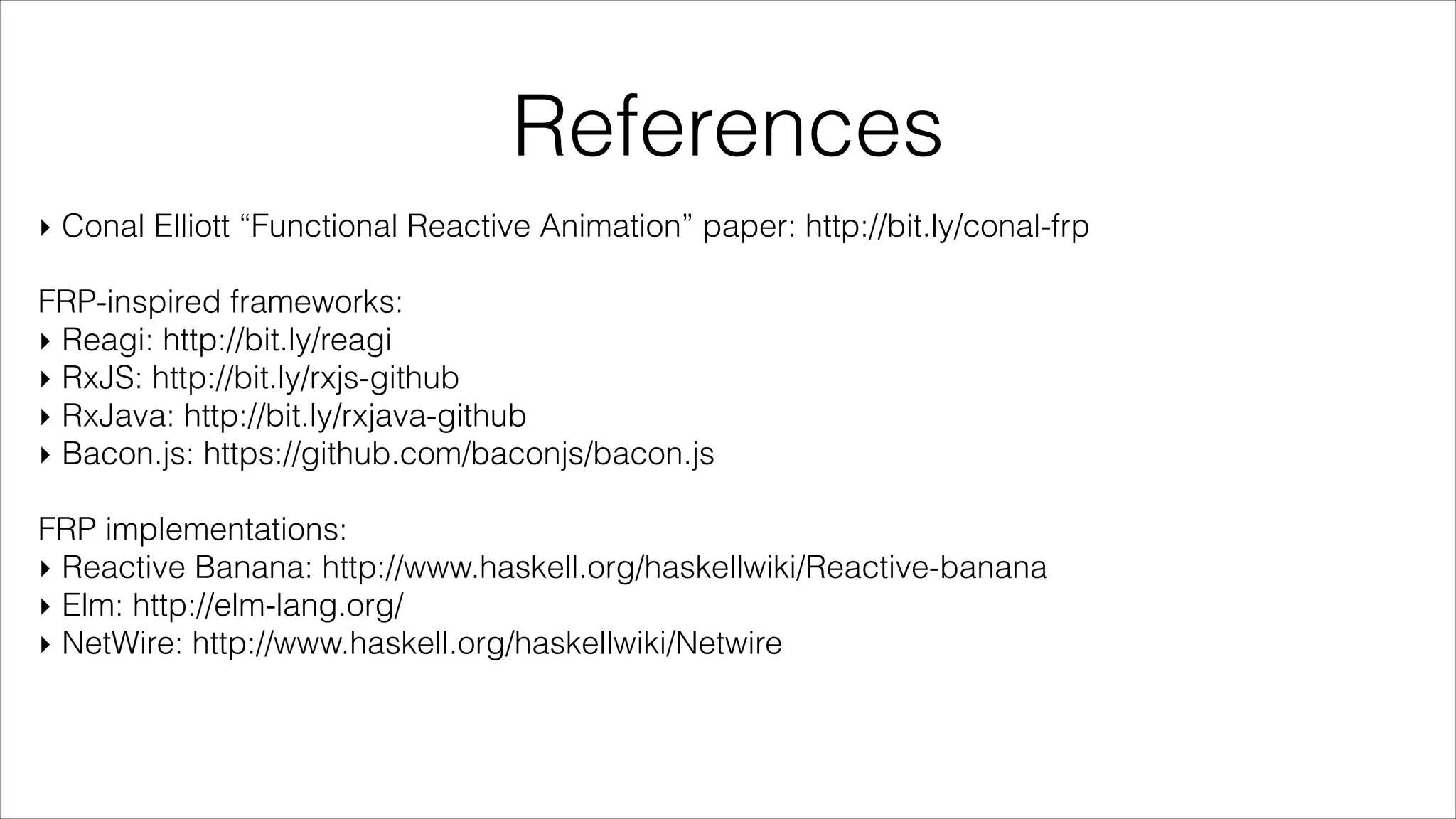This document provides an overview of functional reactive programming (FRP) and compositional event systems (CES). It discusses how FRP approaches handling time-varying values like regular values. It presents an example of modeling game movements reactively using key press events. It also demonstrates how CES can be used to handle asynchronous workflows by turning network responses into observable streams. The document compares CES to other approaches like core.async and discusses benefits of CES like supporting multiple subscribers.



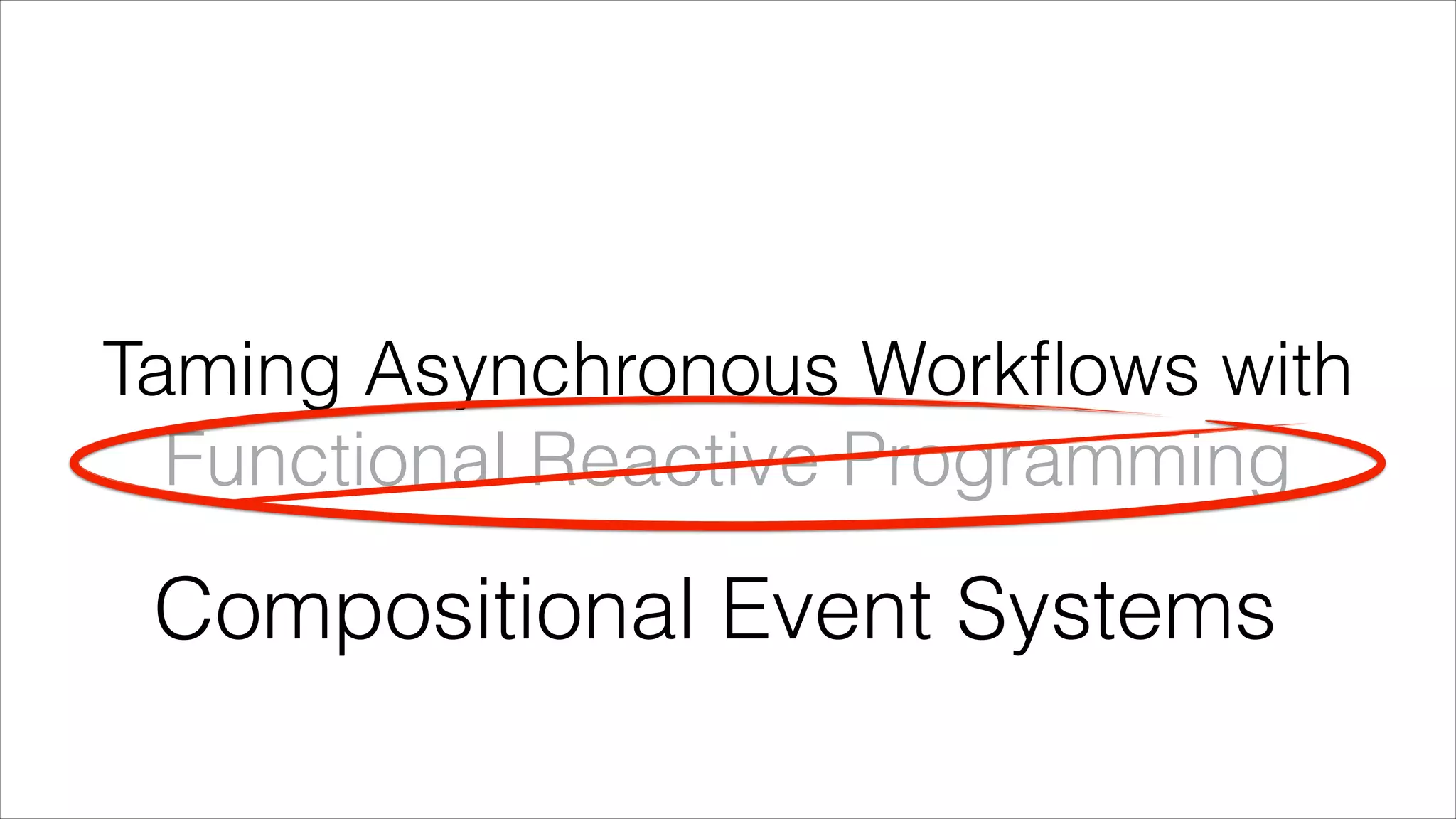
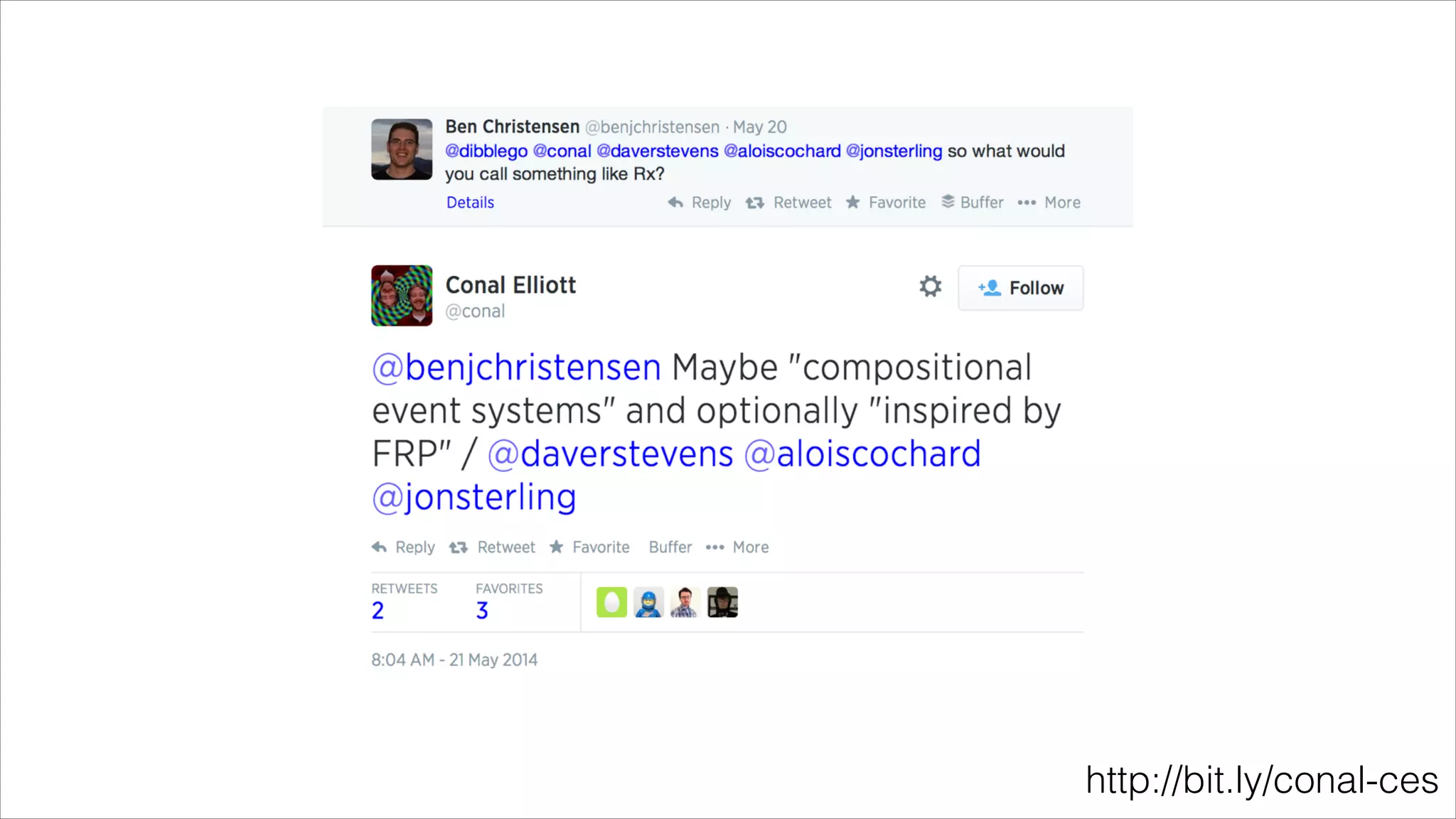
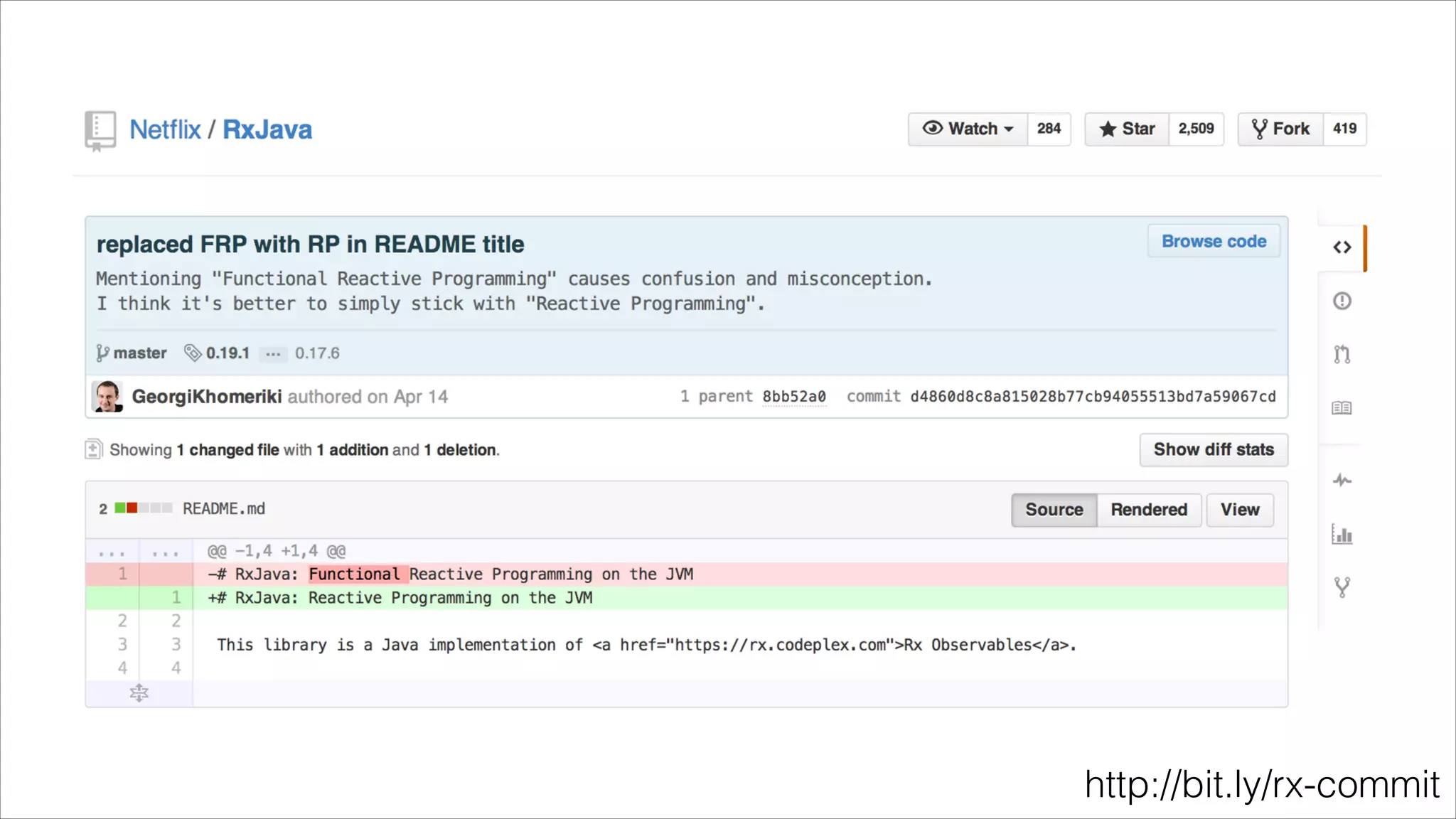
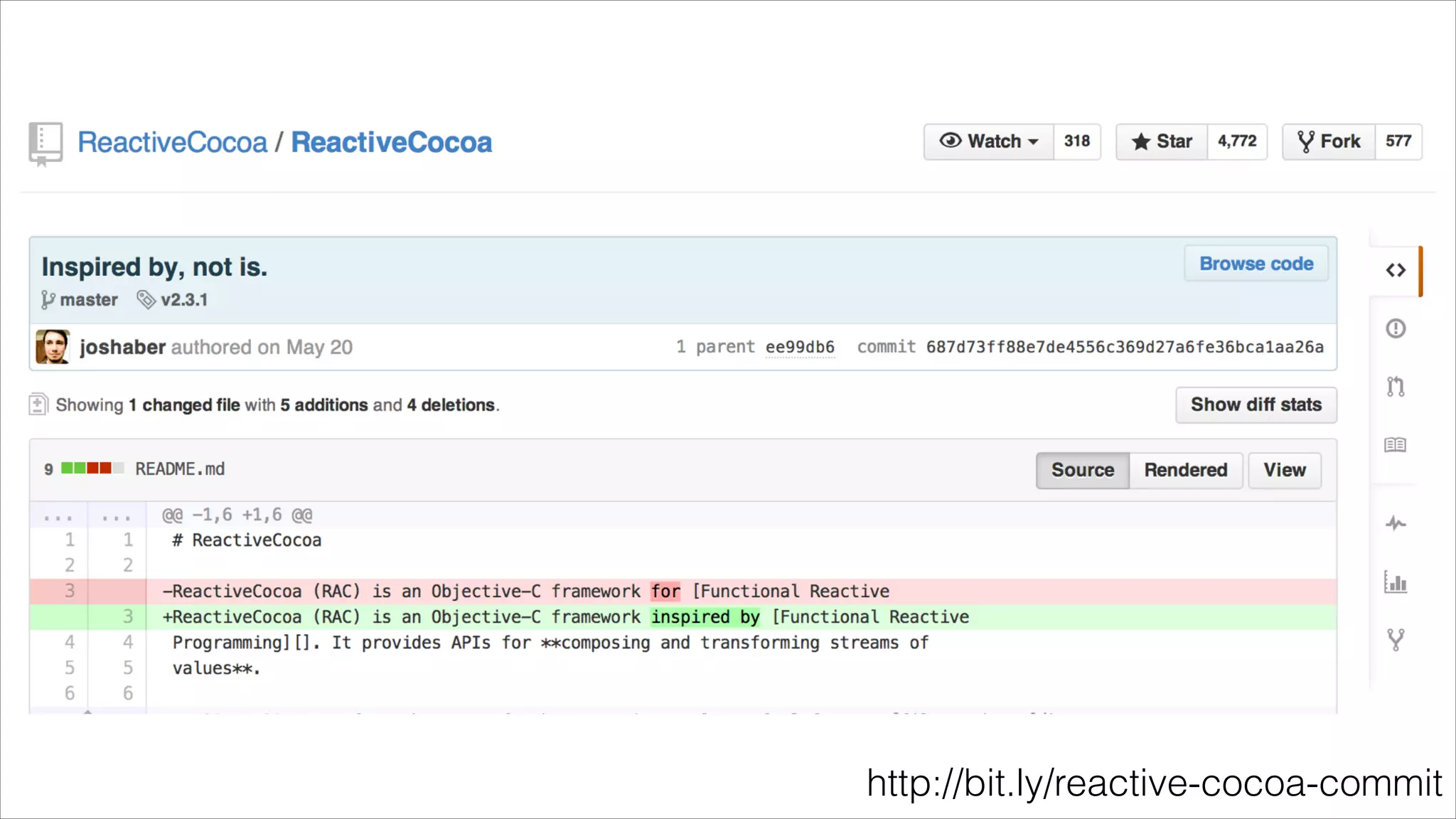
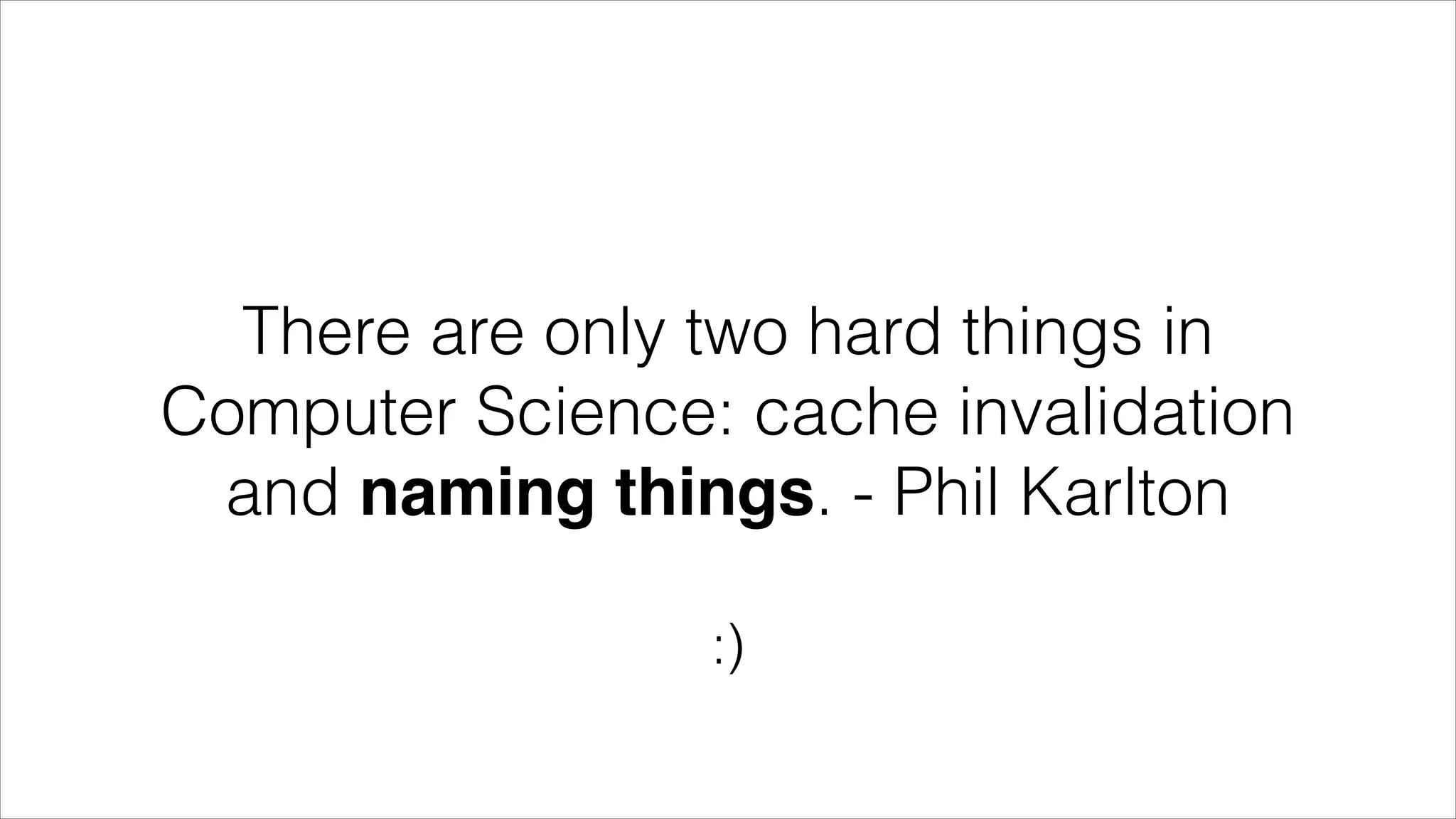

![‣ Created in 1997 by Conal Elliott for the reactive animations framework Fran, in Haskell ‣ Since then other implementations have appeared: reactive-banana, NetWire, Sodium (all in Haskell) ‣ And then FRP-inspired ones: Rx[.NET | Java | JS], Baconjs, reagi (Clojurescript) ‣ Main abstractions: Behaviors e Events More about FRP](https://image.slidesharecdn.com/frp-ces-euroclojure-2014-140627053504-phpapp01/75/Functional-Reactive-Programming-Compositional-Event-Systems-10-2048.jpg)
![‣ Created in 1997 by Conal Elliott for the reactive animations framework Fran, in Haskell ‣ Since then other implementations have appeared: reactive-banana, NetWire, Sodium (all in Haskell) ‣ And then FRP-inspired ones: Rx[.NET | Java | JS], Baconjs, reagi (Clojure[script]) ‣ Main abstractions: Behaviors e Events ‣ Traditionally defined as: type Behavior a = [Time] -> [a]! type Event a = [Time] -> [Maybe a] More about FRP](https://image.slidesharecdn.com/frp-ces-euroclojure-2014-140627053504-phpapp01/75/Functional-Reactive-Programming-Compositional-Event-Systems-11-2048.jpg)


![Imperative programming describes computations as a series of actions which modify program state var result = 1;! numbers.forEach(function(n){! if(n % 2 === 0) {! result *= n;! }! });! console.log( result );! // 8! var numbers = [1,2,3,4,5]; Requires a variable to store state](https://image.slidesharecdn.com/frp-ces-euroclojure-2014-140627053504-phpapp01/75/Functional-Reactive-Programming-Compositional-Event-Systems-14-2048.jpg)
![var result = 1;! numbers.forEach(function(n){! if(n % 2 === 0) {! result *= n;! }! });! console.log( result );! // 8! var numbers = [1,2,3,4,5]; We iterate over the array Imperative programming describes computations as a series of actions which modify program state](https://image.slidesharecdn.com/frp-ces-euroclojure-2014-140627053504-phpapp01/75/Functional-Reactive-Programming-Compositional-Event-Systems-15-2048.jpg)
![var result = 1;! numbers.forEach(function(n){! if(n % 2 === 0) {! result *= n;! }! });! console.log( result );! // 8! var numbers = [1,2,3,4,5]; And then we filter the items… Imperative programming describes computations as a series of actions which modify program state](https://image.slidesharecdn.com/frp-ces-euroclojure-2014-140627053504-phpapp01/75/Functional-Reactive-Programming-Compositional-Event-Systems-16-2048.jpg)
![var result = 1;! numbers.forEach(function(n){! if(n % 2 === 0) {! result *= n;! }! });! console.log( result );! // 8! var numbers = [1,2,3,4,5]; …and perform the multiplication in the same function Imperative programming describes computations as a series of actions which modify program state](https://image.slidesharecdn.com/frp-ces-euroclojure-2014-140627053504-phpapp01/75/Functional-Reactive-Programming-Compositional-Event-Systems-17-2048.jpg)
![(def numbers [1 2 3 4 5])! ! (def result! (->> numbers! (filter even?)! (reduce *)))! ! (prn result)! ! ;; 8 In functional programming, we describe what we want to do but not how we want it done](https://image.slidesharecdn.com/frp-ces-euroclojure-2014-140627053504-phpapp01/75/Functional-Reactive-Programming-Compositional-Event-Systems-18-2048.jpg)
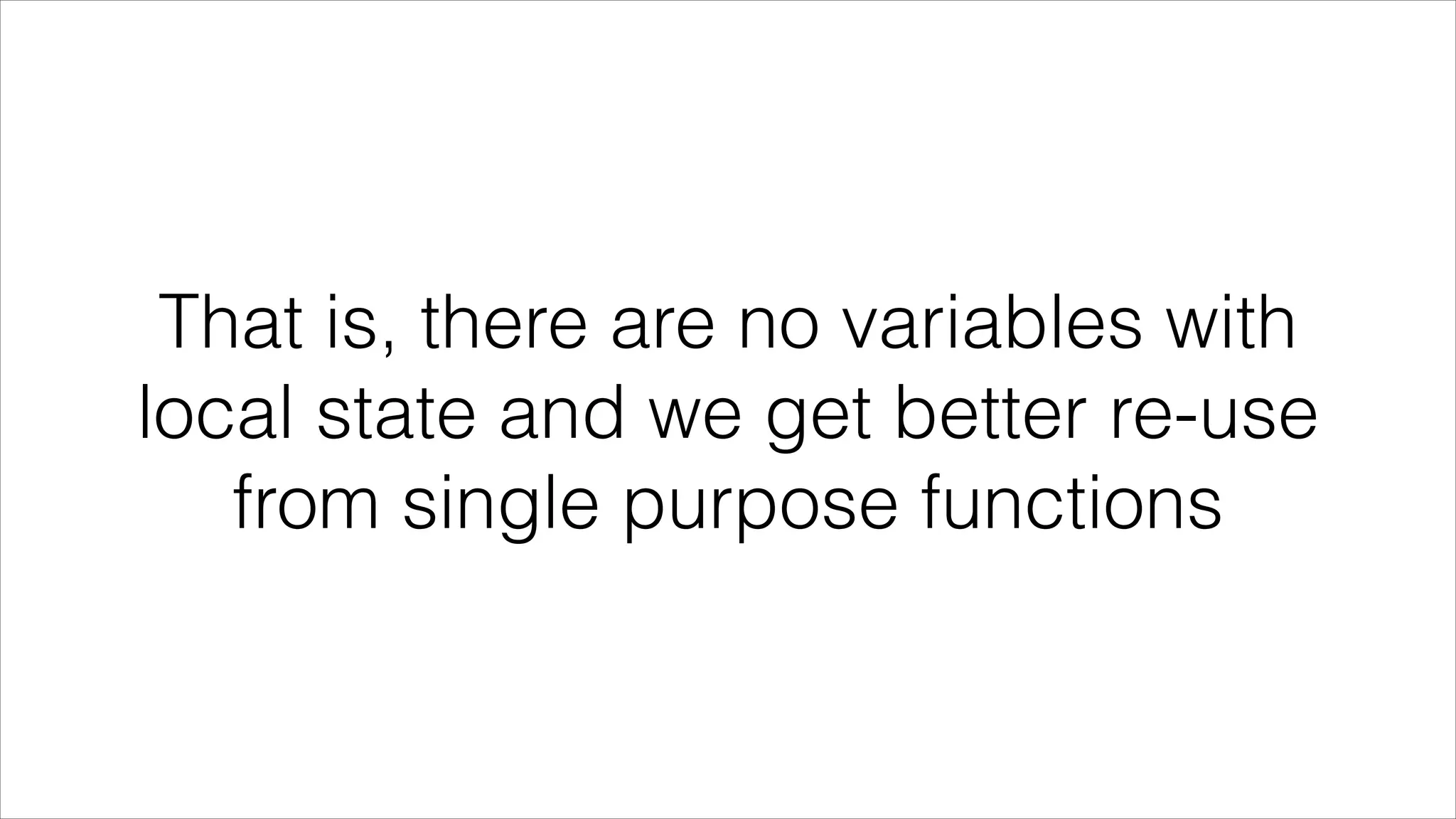
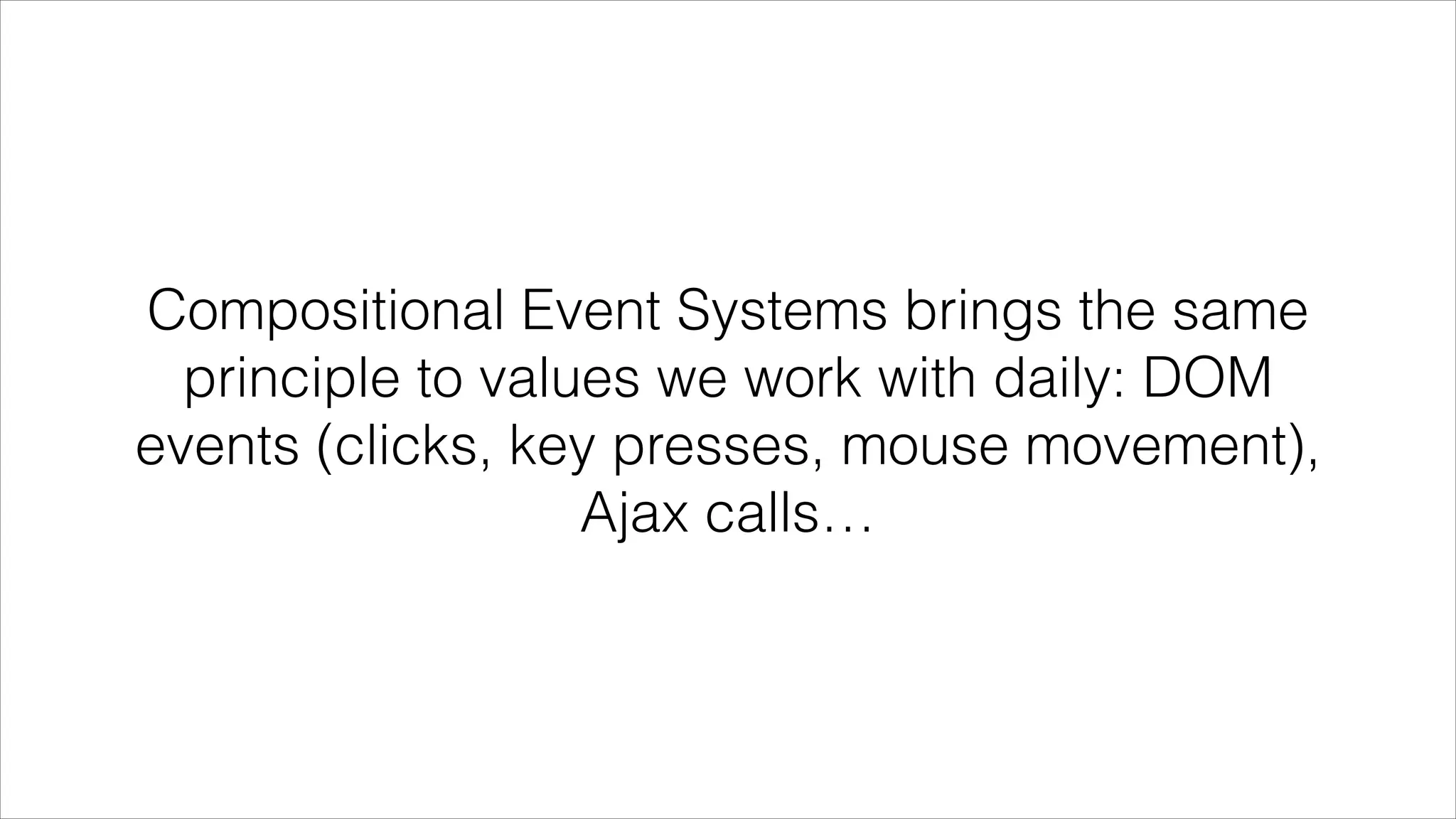

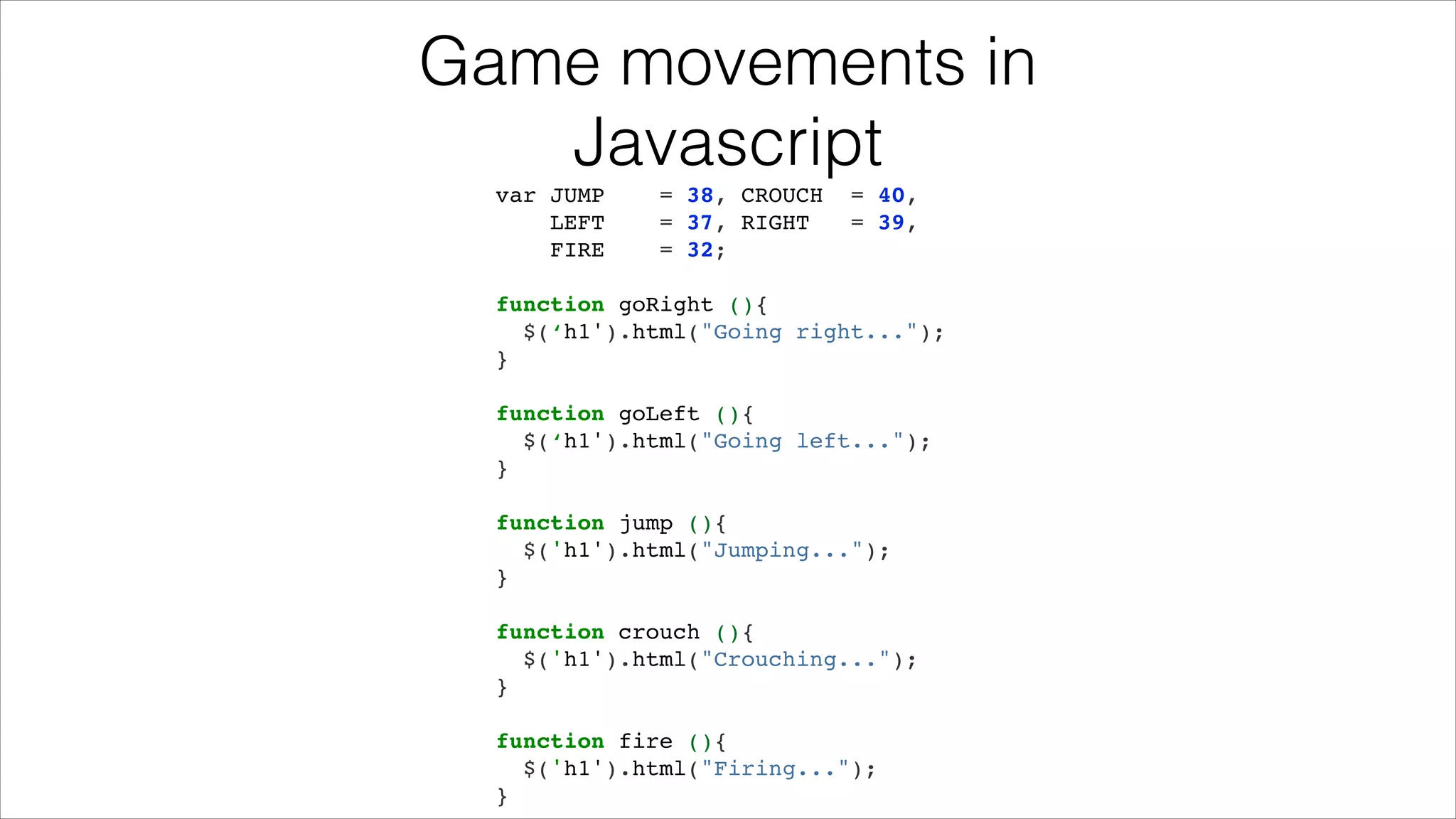
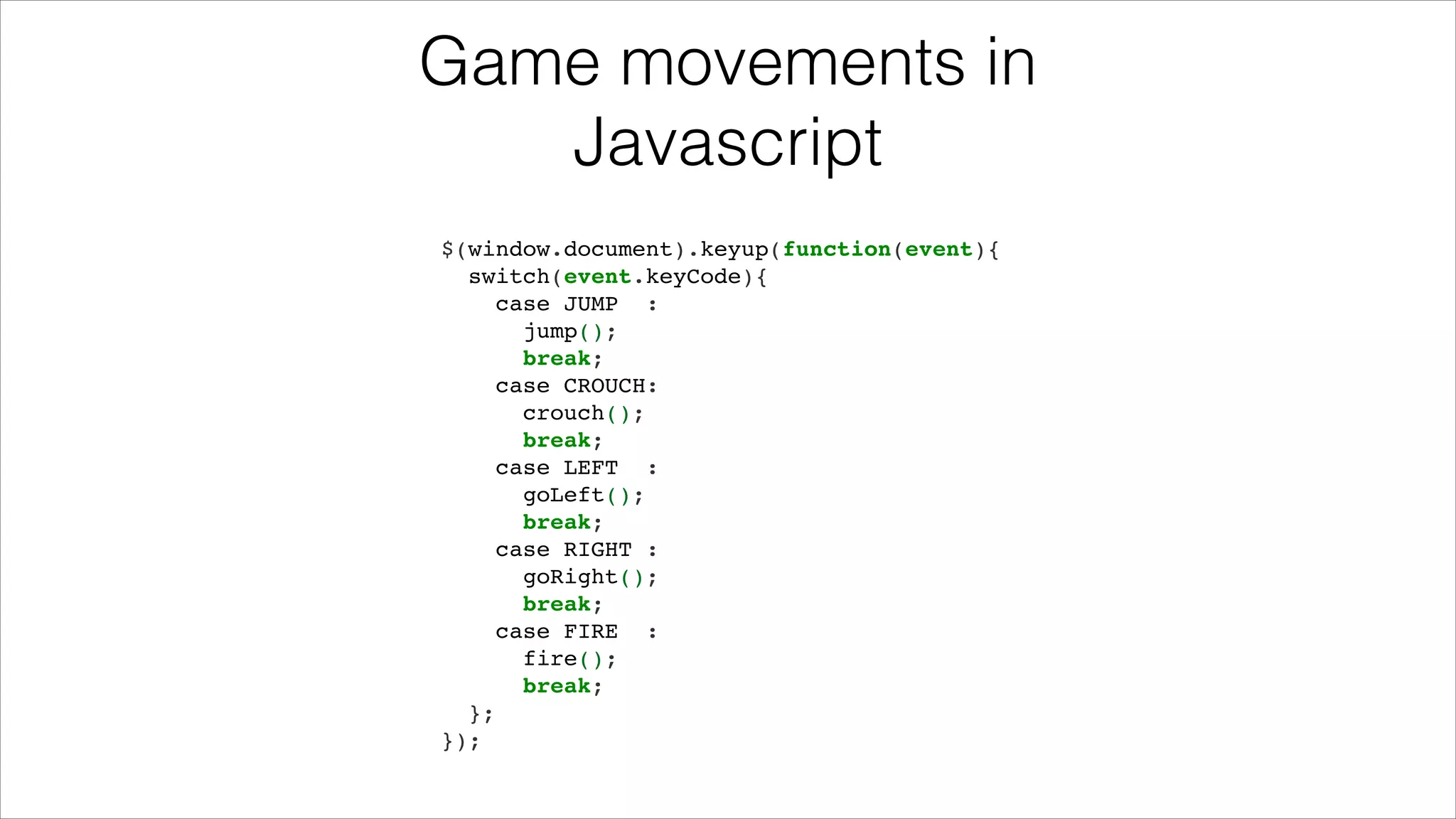



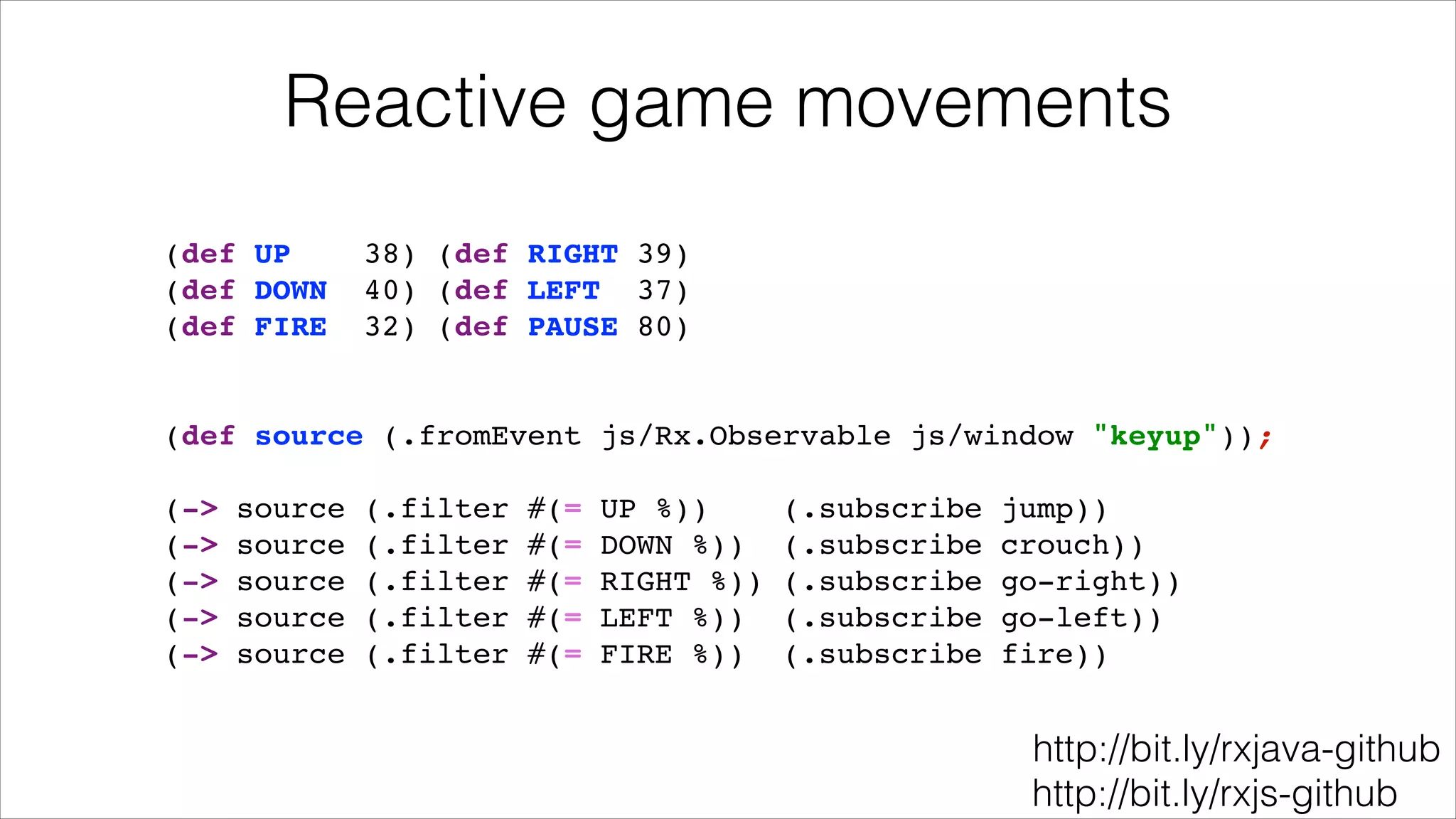
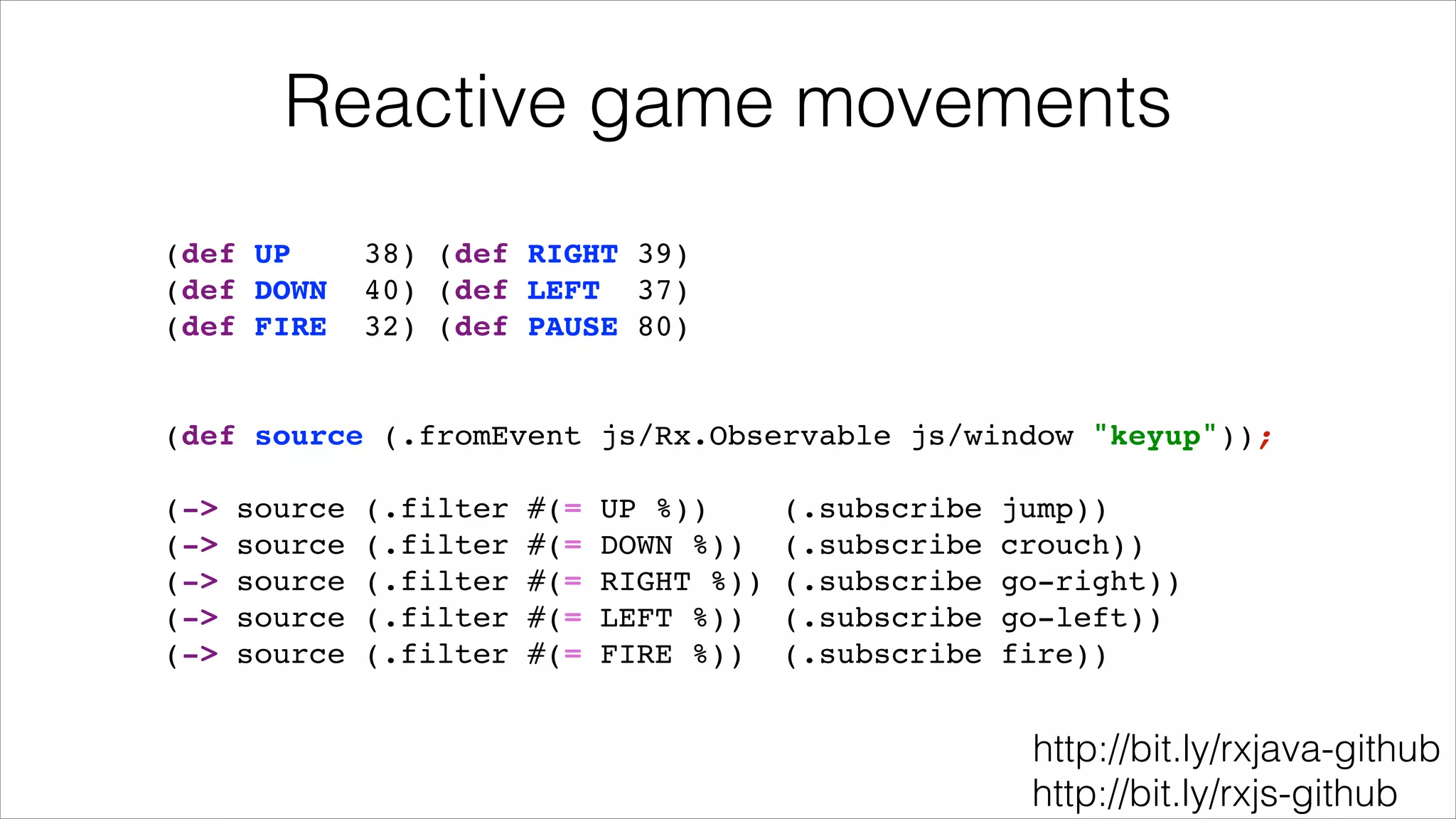
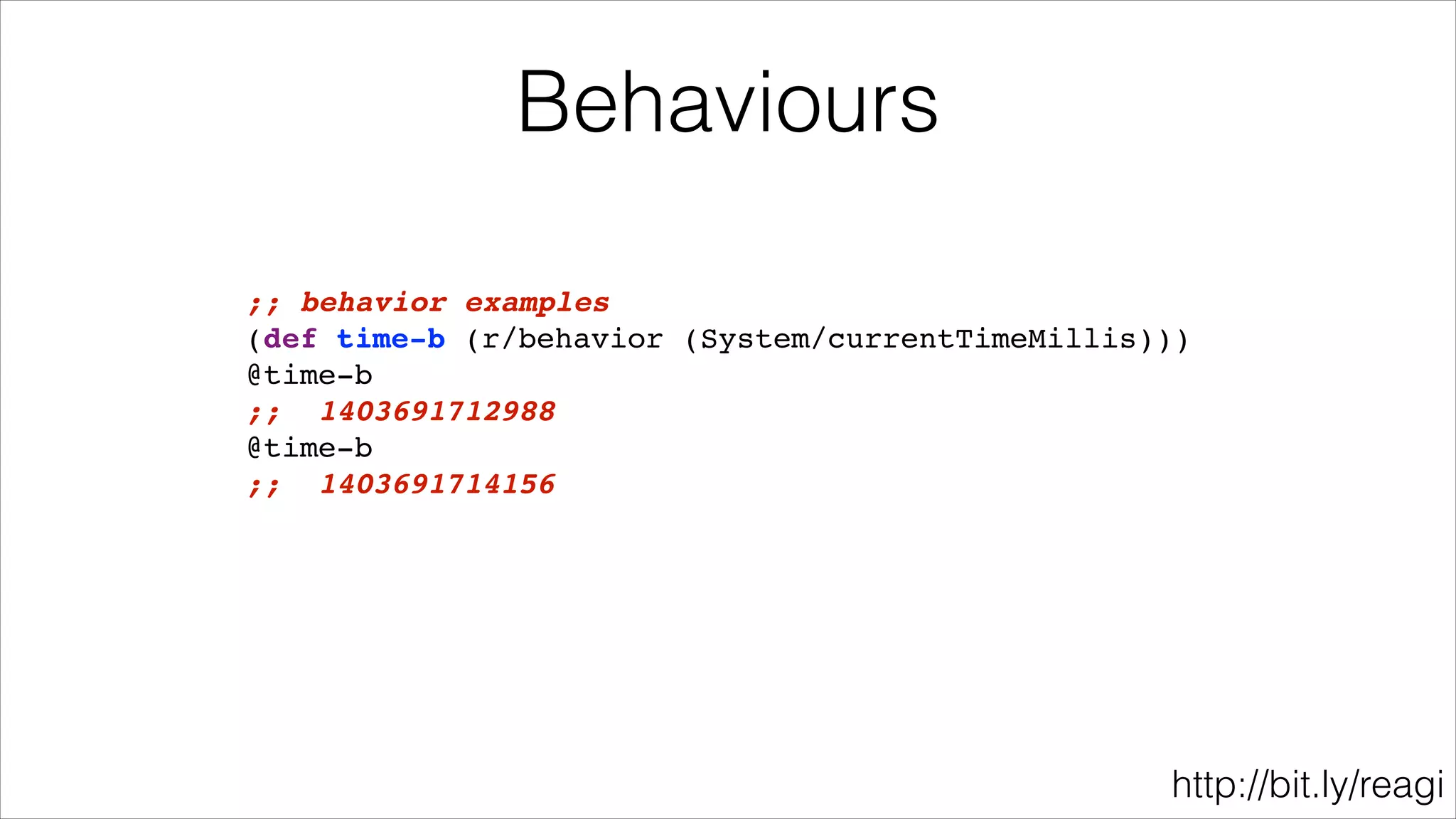
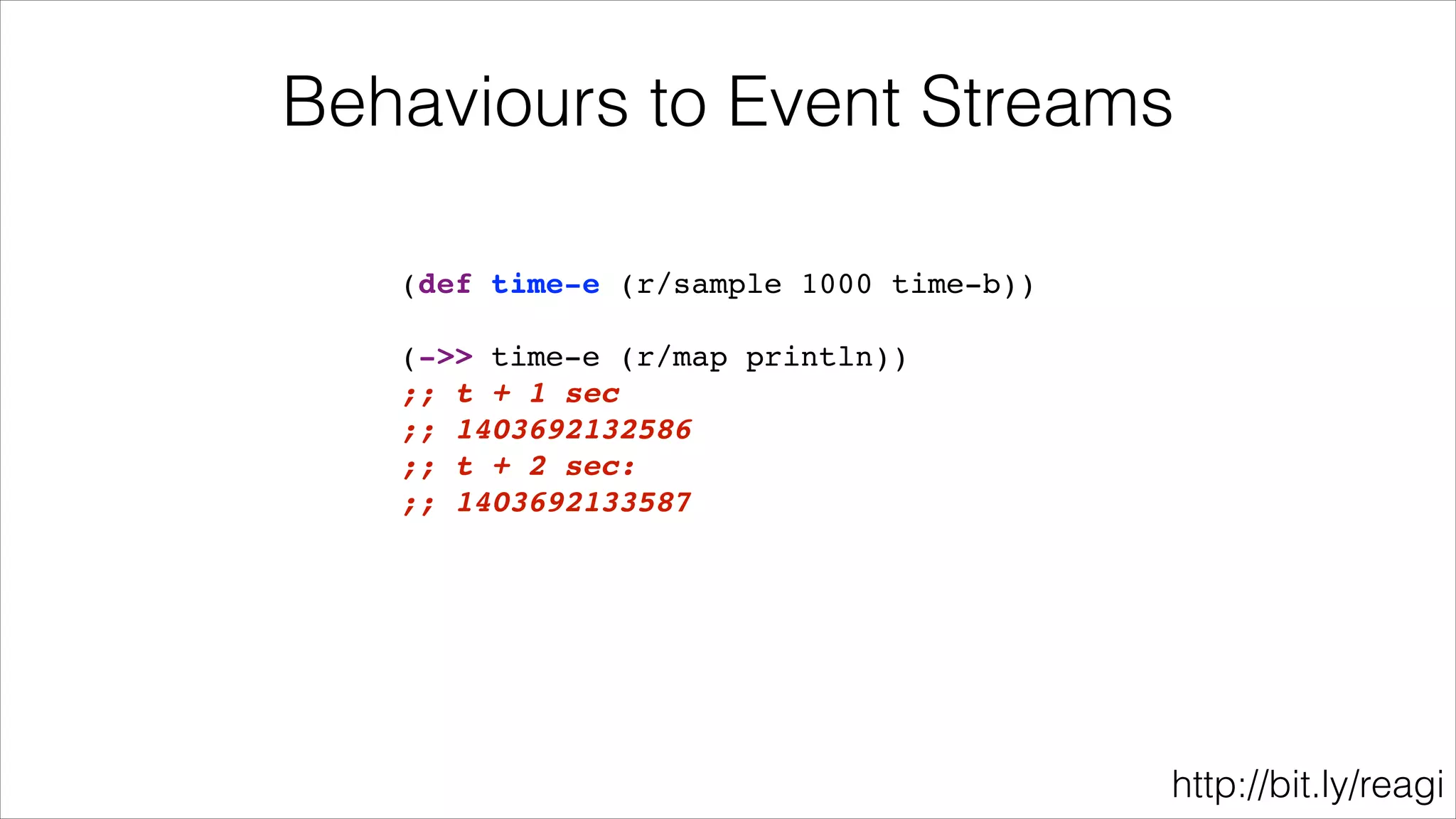
![Combinators (-> (Observable/return 42)! (.map #(* % 2))! (.subscribe println))! ! ;; 84! ! (-> (Observable/from [10 20 30])! (.map #(* % 2))! (.reduce +)! (.subscribe println))! ! ;; 120!](https://image.slidesharecdn.com/frp-ces-euroclojure-2014-140627053504-phpapp01/75/Functional-Reactive-Programming-Compositional-Event-Systems-31-2048.jpg)
![Combinators: flatMap / selectMany (defn project-range [n]! (Rx.Observable/return (range n)))! ! (-> (Observable/from [1 2 3])! (.selectMany project-range)! (.subscribe (rx/fn* println)))! ! ;; 0! ;; 0! ;; 1! ;; 0! ;; 1! ;; 2!](https://image.slidesharecdn.com/frp-ces-euroclojure-2014-140627053504-phpapp01/75/Functional-Reactive-Programming-Compositional-Event-Systems-32-2048.jpg)

![(Observable/from [1 2 3]) 1 2 3](https://image.slidesharecdn.com/frp-ces-euroclojure-2014-140627053504-phpapp01/75/Functional-Reactive-Programming-Compositional-Event-Systems-34-2048.jpg)
![(-> (Observable/from [1 2 3])! (.selectMany project-range)! …) (project-range 2) 0 1 (project-range 1) 0 (project-range 3) 0 1 2 0 0 1 0 1 2](https://image.slidesharecdn.com/frp-ces-euroclojure-2014-140627053504-phpapp01/75/Functional-Reactive-Programming-Compositional-Event-Systems-35-2048.jpg)
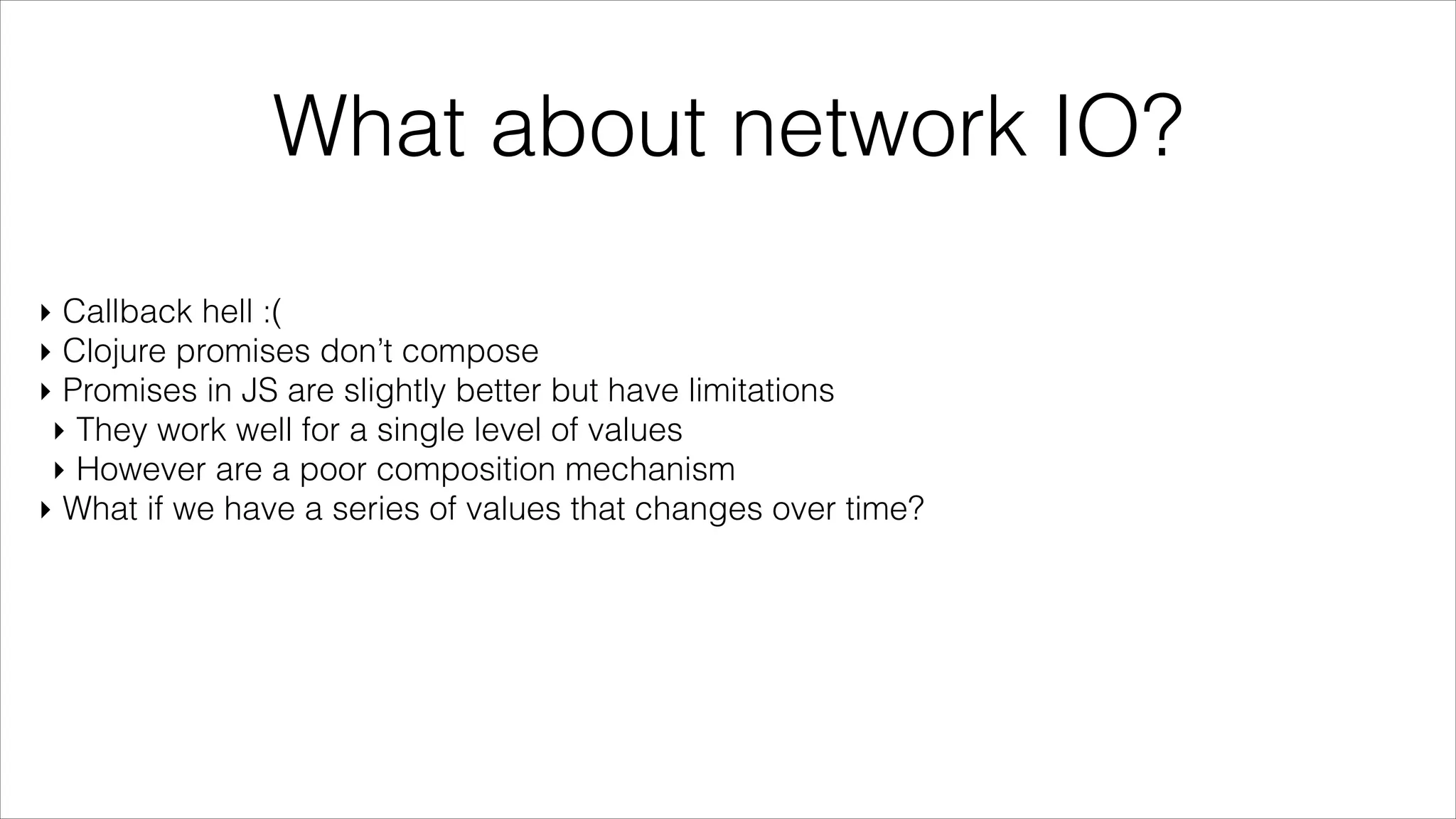

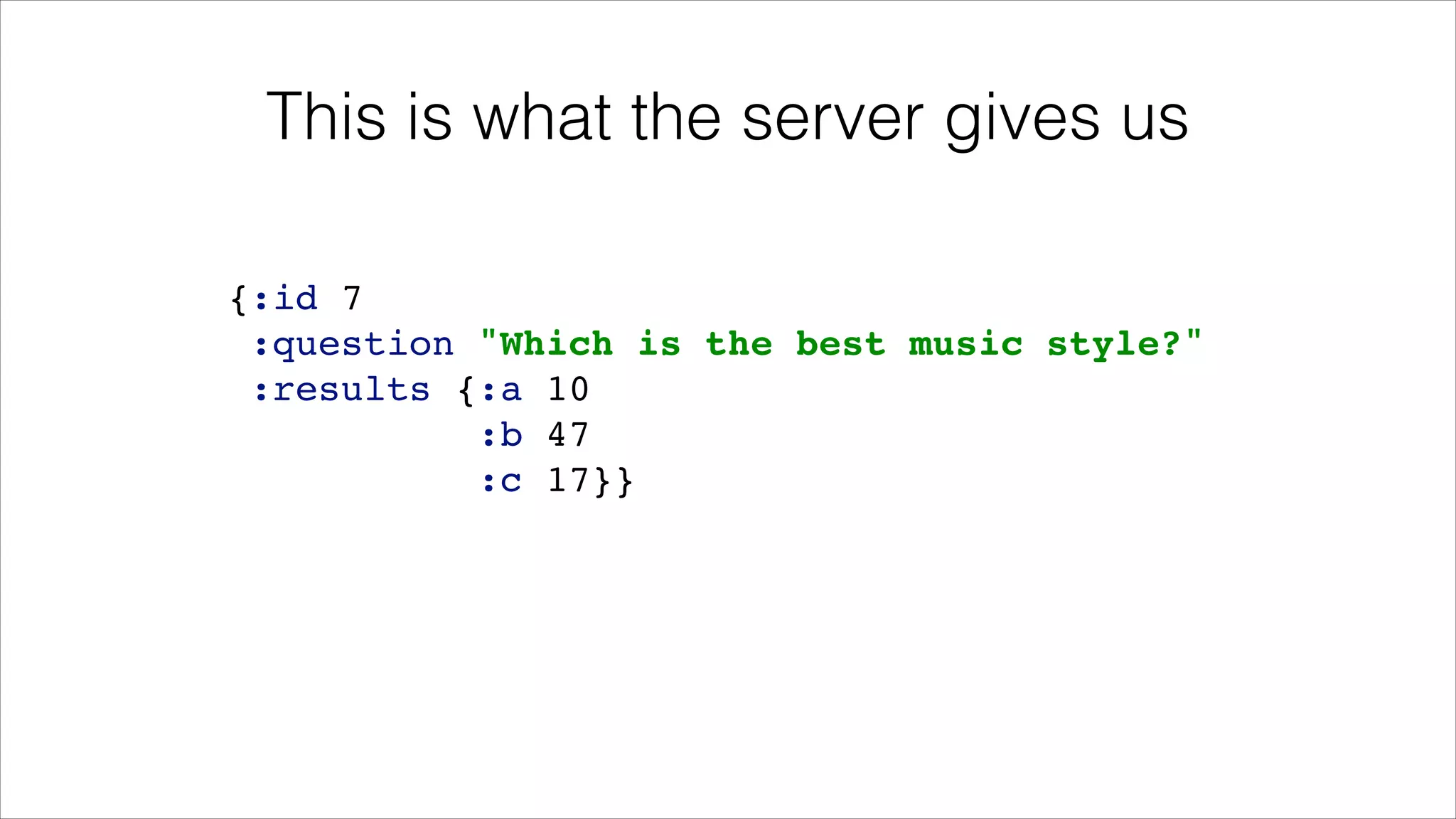
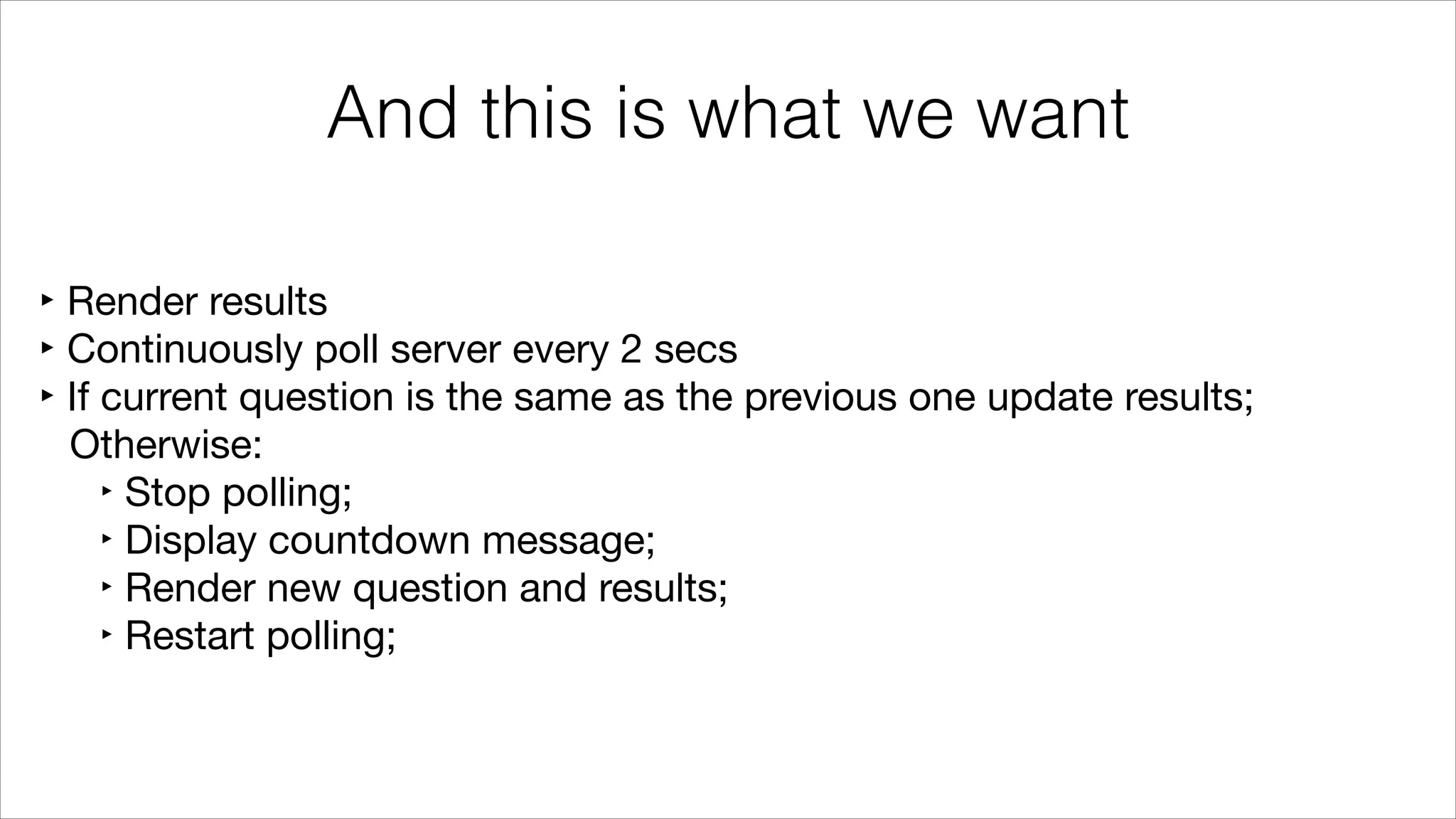

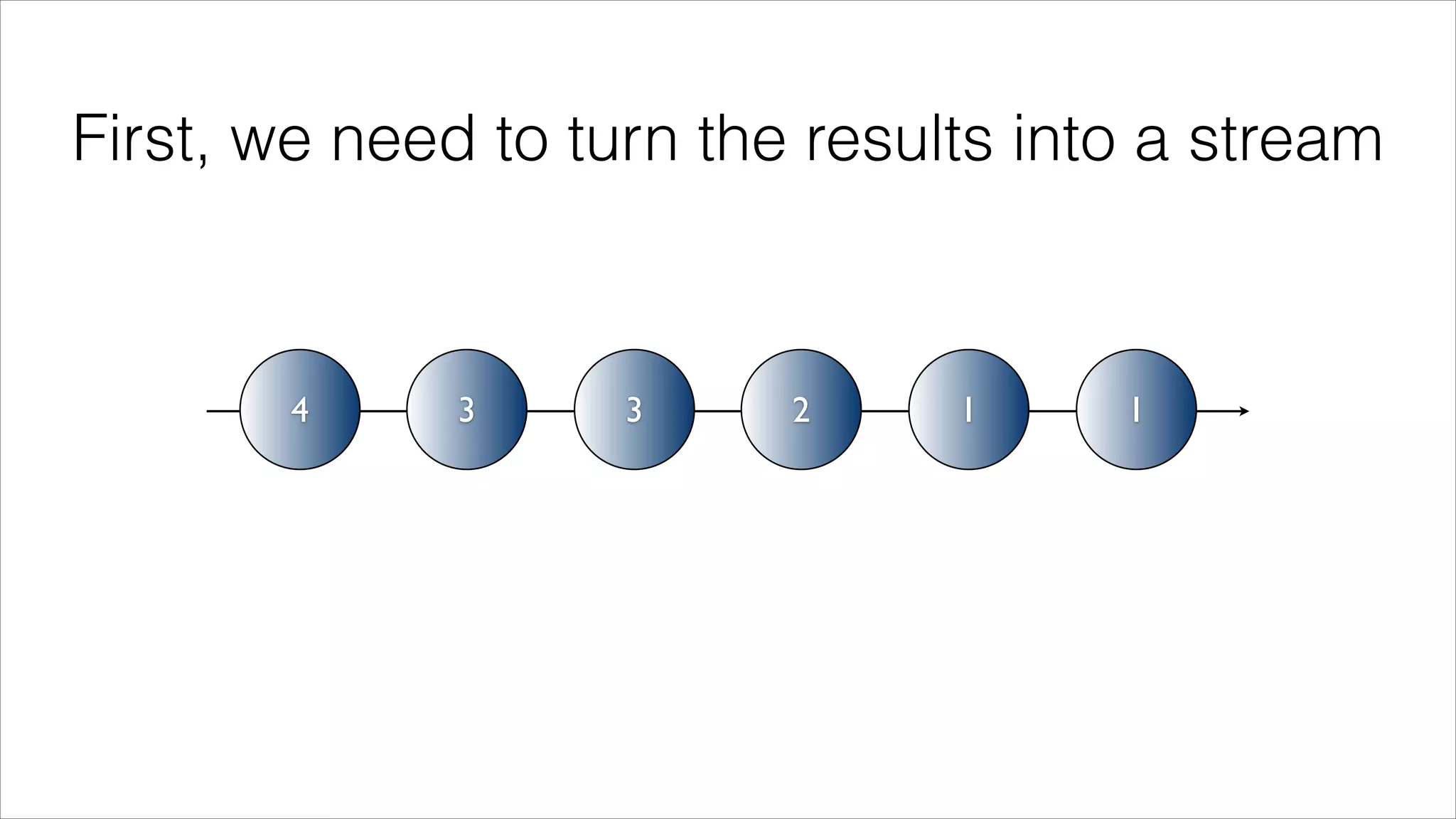
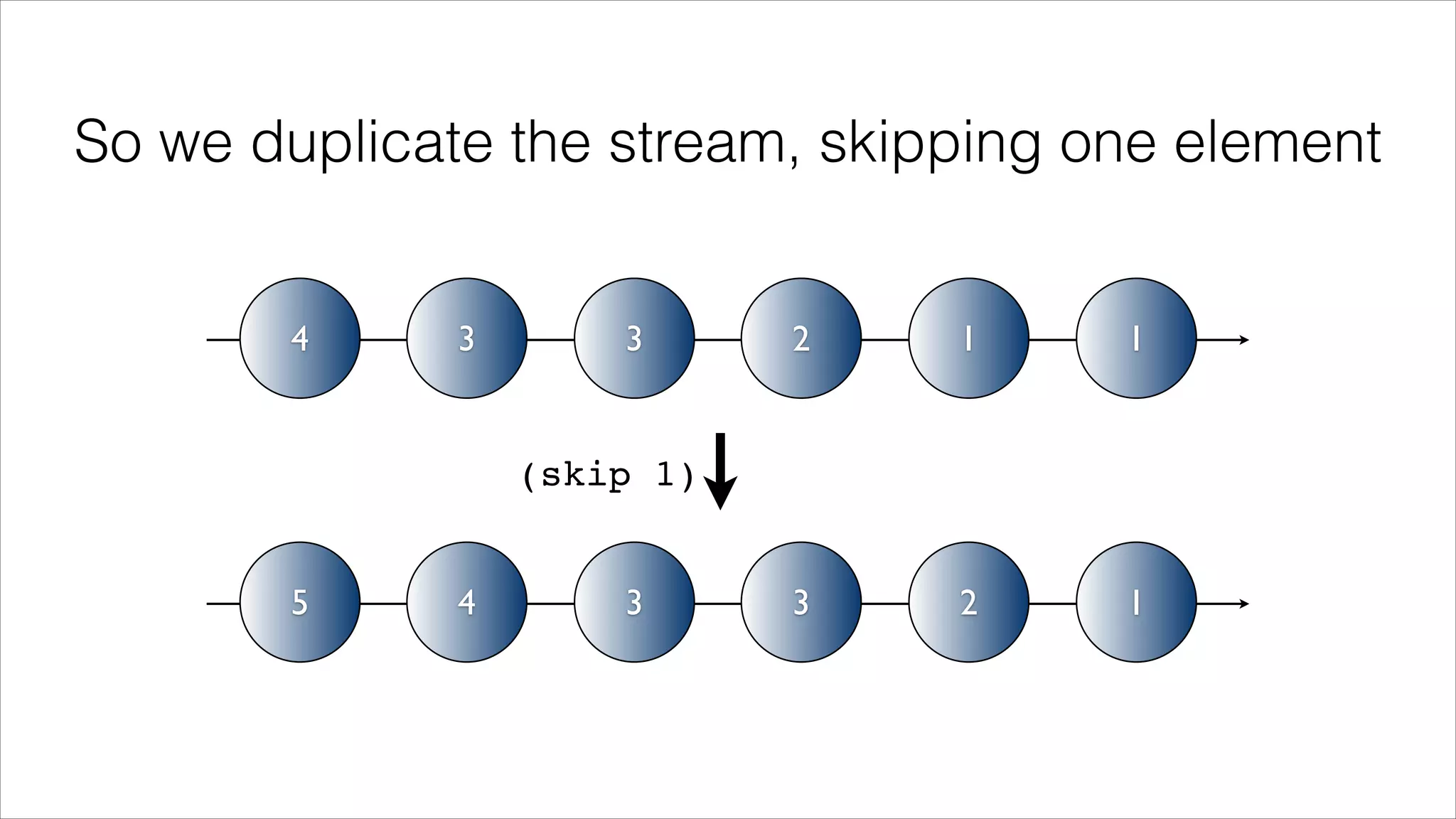
![Finally, we zip the streams 4 3 3 2 1 1 5 4 3 3 2 1 zip [5,4] [4,3] [3,3] [3,2] [2,1] [1,1]](https://image.slidesharecdn.com/frp-ces-euroclojure-2014-140627053504-phpapp01/75/Functional-Reactive-Programming-Compositional-Event-Systems-43-2048.jpg)
![The core idea, in code (defn results-observable! "Returns an Observable that yields server-side questions/results"! []! (.create js/Rx.Observable! (fn [observer]! (srm/rpc! (poll-results) [resp]! (.onNext observer resp))! (fn [] (.log js/console "Disposed")))))](https://image.slidesharecdn.com/frp-ces-euroclojure-2014-140627053504-phpapp01/75/Functional-Reactive-Programming-Compositional-Event-Systems-44-2048.jpg)
![The core idea, in code (def results-connectable! "Zips results-observable with itself, but shifted by 1.! This simulates a 'buffer' or 'window' of results"! (let [obs (-> js/Rx.Observable! (.interval 2000)! (.selectMany results-observable)! (.publish)! (.refCount))! obs-1 (.skip obs 1)]! (.zip obs obs-1 (fn [prev curr]! {:prev prev! :curr curr}))))! Turn results into a stream](https://image.slidesharecdn.com/frp-ces-euroclojure-2014-140627053504-phpapp01/75/Functional-Reactive-Programming-Compositional-Event-Systems-45-2048.jpg)
![The core idea, in code (def results-connectable! "Zips results-observable with itself, but shifted by 1.! This simulates a 'buffer' or 'window' of results"! (let [obs (-> js/Rx.Observable! (.interval 2000)! (.selectMany results-observable)! (.publish)! (.refCount))! obs-1 (.skip obs 1)]! (.zip obs obs-1 (fn [prev curr]! {:prev prev! :curr curr}))))! Clone stream, skip one](https://image.slidesharecdn.com/frp-ces-euroclojure-2014-140627053504-phpapp01/75/Functional-Reactive-Programming-Compositional-Event-Systems-46-2048.jpg)
![The core idea, in code (def results-connectable! "Zips results-observable with itself, but shifted by 1.! This simulates a 'buffer' or 'window' of results"! (let [obs (-> js/Rx.Observable! (.interval 2000)! (.selectMany results-observable))! obs-1 (.skip obs 1)]! (.zip obs obs-1 (fn [prev curr]! {:prev prev! :curr curr}))))! Zip them together](https://image.slidesharecdn.com/frp-ces-euroclojure-2014-140627053504-phpapp01/75/Functional-Reactive-Programming-Compositional-Event-Systems-47-2048.jpg)

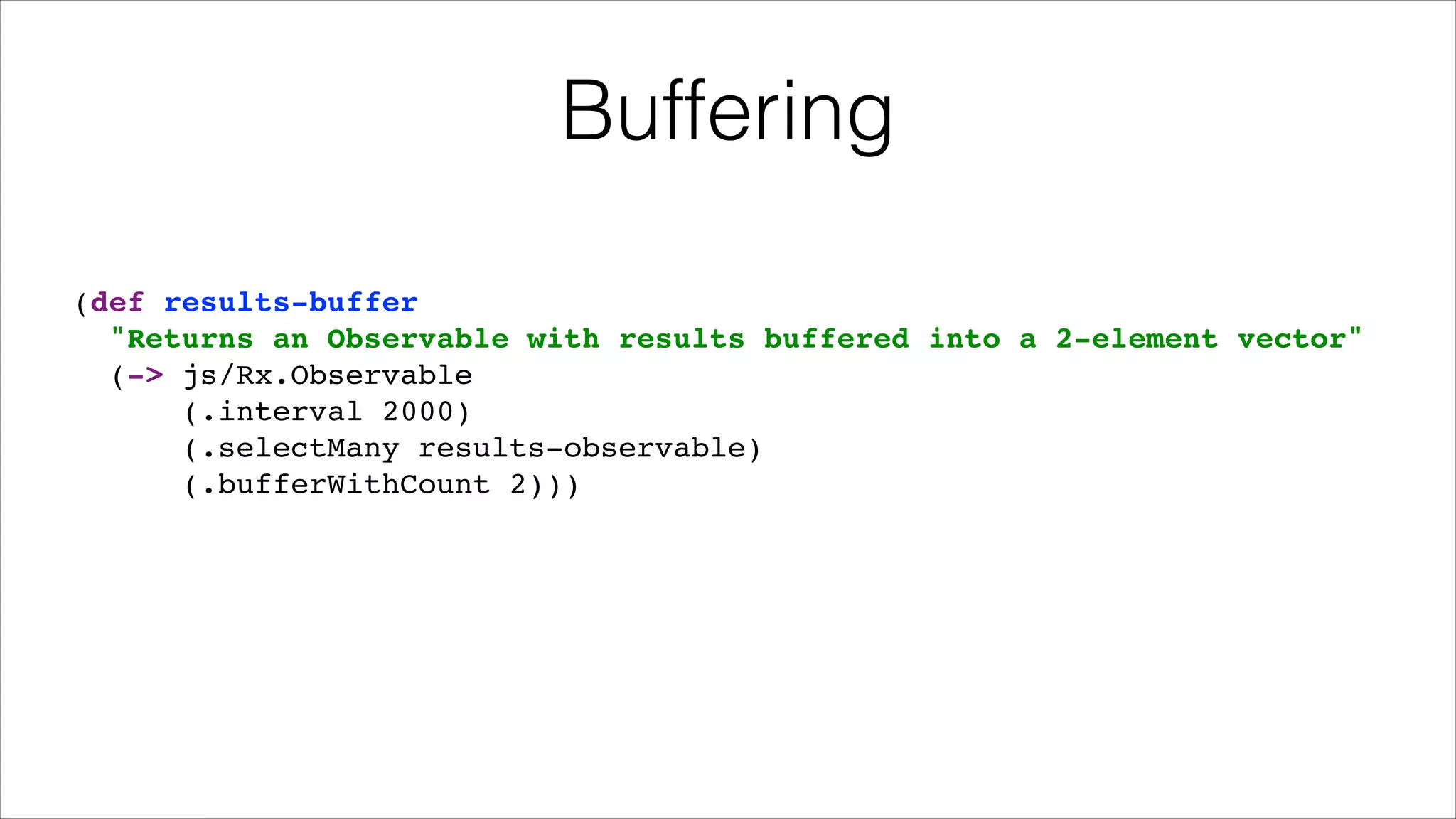


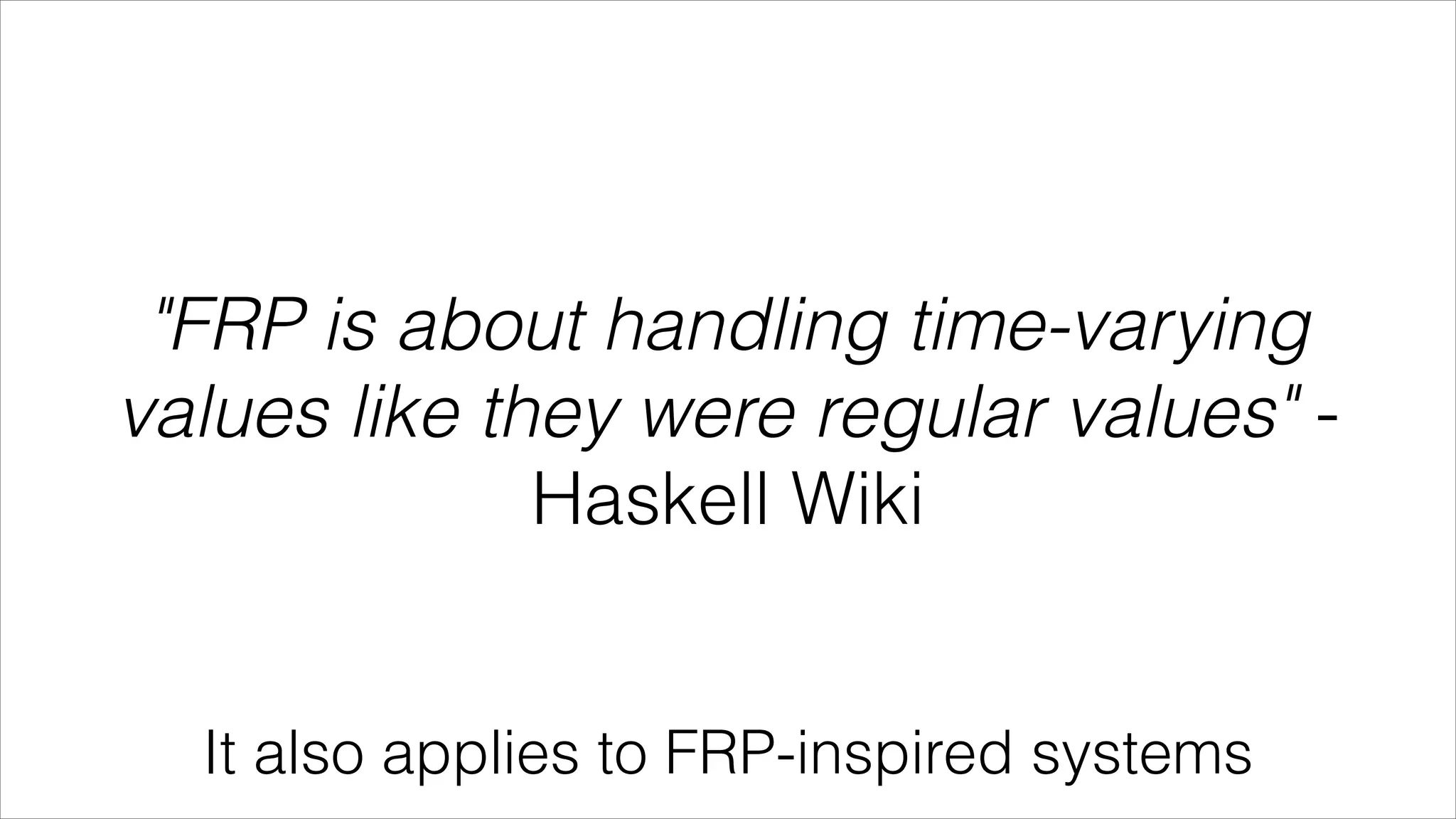

![Previously, with CES (-> (Observable/from [10 20 30])! (.map (rx/fn [v] (* v 2)))! (.reduce (rx/fn* +)! (.subscribe (rx/fn* println)))))](https://image.slidesharecdn.com/frp-ces-euroclojure-2014-140627053504-phpapp01/75/Functional-Reactive-Programming-Compositional-Event-Systems-54-2048.jpg)
![With core.async (defn from-array [coll]! (let [stream-c (chan)]! (go (doseq [n coll]! (>! stream-c n))! (close! stream-c))! stream-c))! ! (def c (->> (async-from [10 20 30])! (a/map< #(* % 2))! (a/reduce + 0)))! ! (go-loop []! (when-let [v (<! c)]! (println v)! (recur)))!](https://image.slidesharecdn.com/frp-ces-euroclojure-2014-140627053504-phpapp01/75/Functional-Reactive-Programming-Compositional-Event-Systems-55-2048.jpg)
![Multiple subscribers with CES (def sum-of-squares (-> (Observable/from [10 20 30])! (.map (rx/fn [v] (* v 2)))! (.reduce (rx/fn* +))))! ! ! ! (.subscribe sum-of-squares (rx/action* println)) ;; 120! (.subscribe sum-of-squares (rx/action* println)) ;; 120](https://image.slidesharecdn.com/frp-ces-euroclojure-2014-140627053504-phpapp01/75/Functional-Reactive-Programming-Compositional-Event-Systems-56-2048.jpg)
![Multiple subscribers with core.async [1/3] (def in (chan))! (def sum-of-squares (->> in! (a/map< #(* % 2))! (a/reduce + 0)))!](https://image.slidesharecdn.com/frp-ces-euroclojure-2014-140627053504-phpapp01/75/Functional-Reactive-Programming-Compositional-Event-Systems-57-2048.jpg)
![Multiple subscribers with core.async [2/3] (def publication (pub sum-of-squares (fn [_] :n)))! ! (def sub-1 (chan))! (def sub-2 (chan))! ! (sub publication :n sub-1)! (sub publication :n sub-2)](https://image.slidesharecdn.com/frp-ces-euroclojure-2014-140627053504-phpapp01/75/Functional-Reactive-Programming-Compositional-Event-Systems-58-2048.jpg)
![Multiple subscribers with core.async [3/3] (go (doseq [n [10 20 30]]! (>! in n))! (close! in))! ! (go-loop []! (when-let [v (<! sub-1)]! (prn v)! (recur))) ;; 120! ! (go-loop []! (when-let [v (<! sub-2)]! (prn v)! (recur))) ;; 120](https://image.slidesharecdn.com/frp-ces-euroclojure-2014-140627053504-phpapp01/75/Functional-Reactive-Programming-Compositional-Event-Systems-59-2048.jpg)

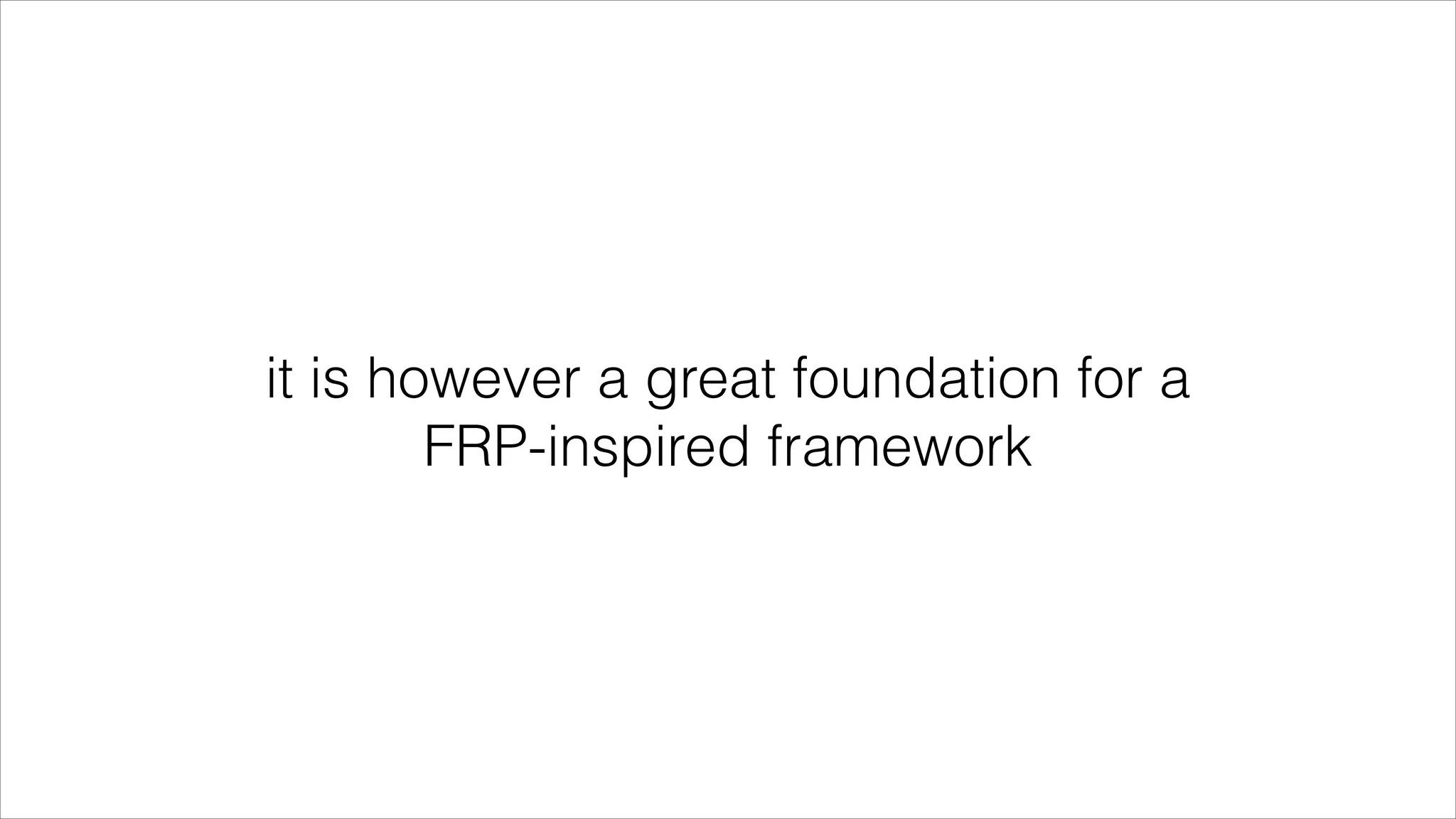
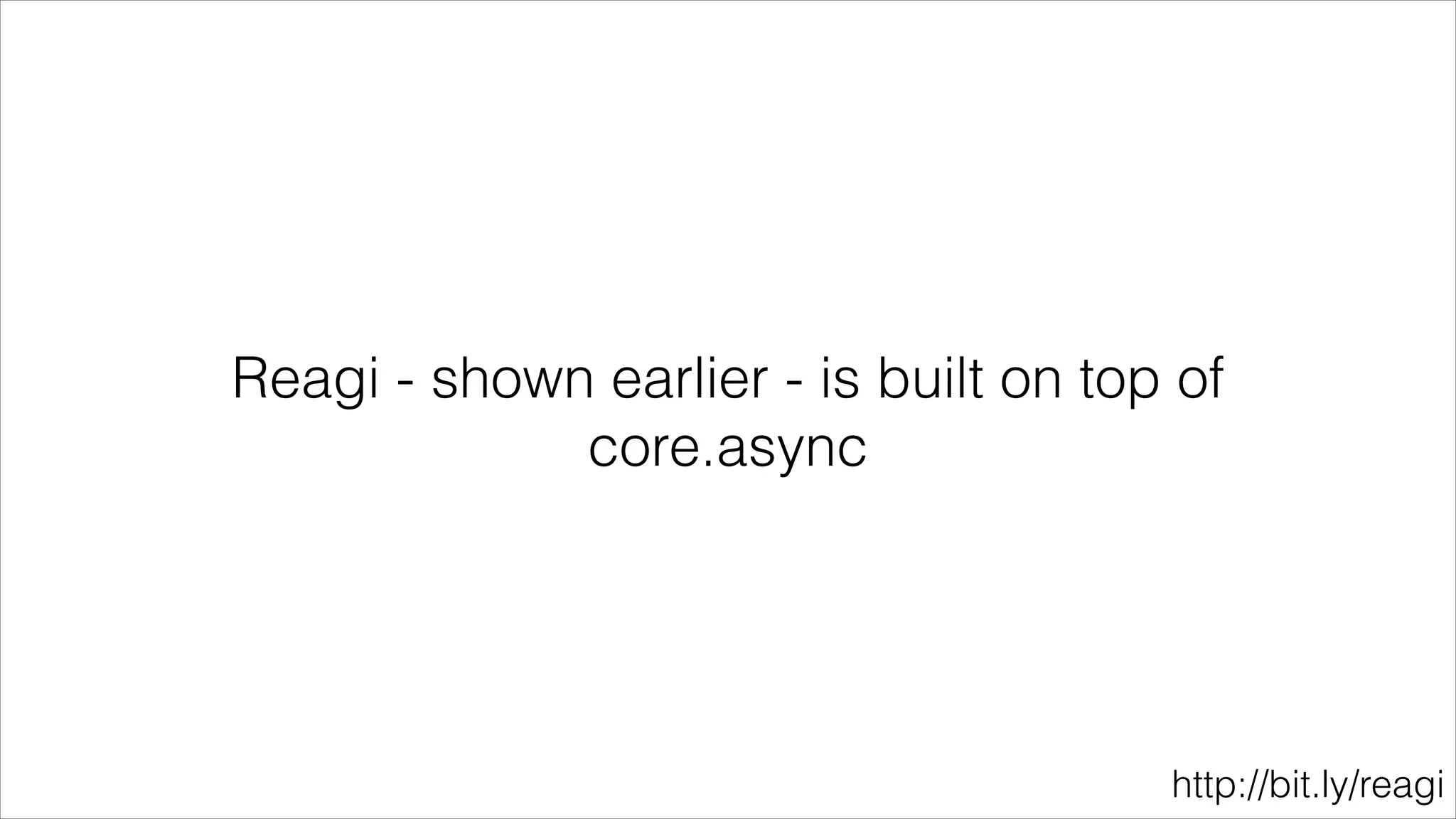
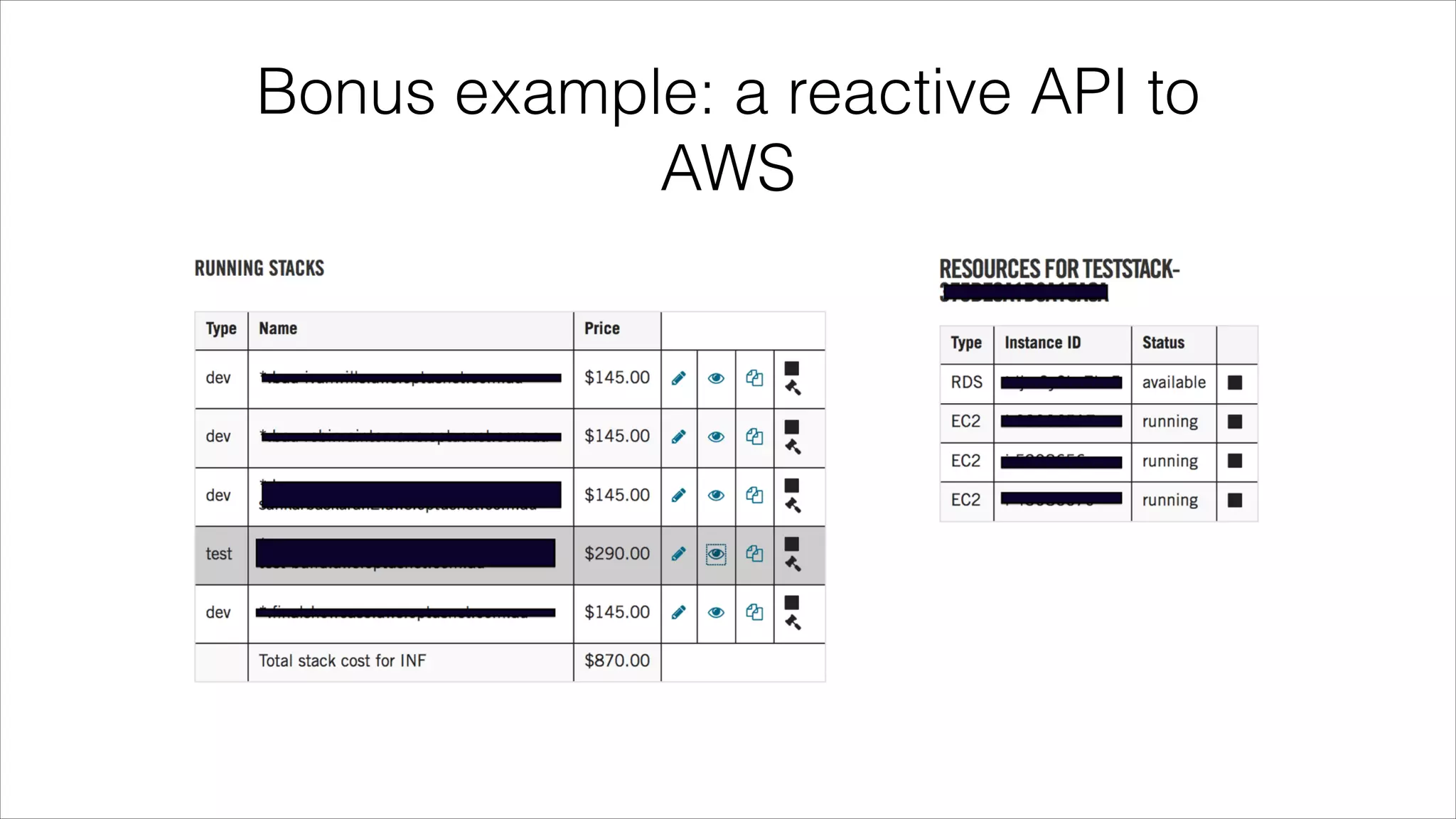
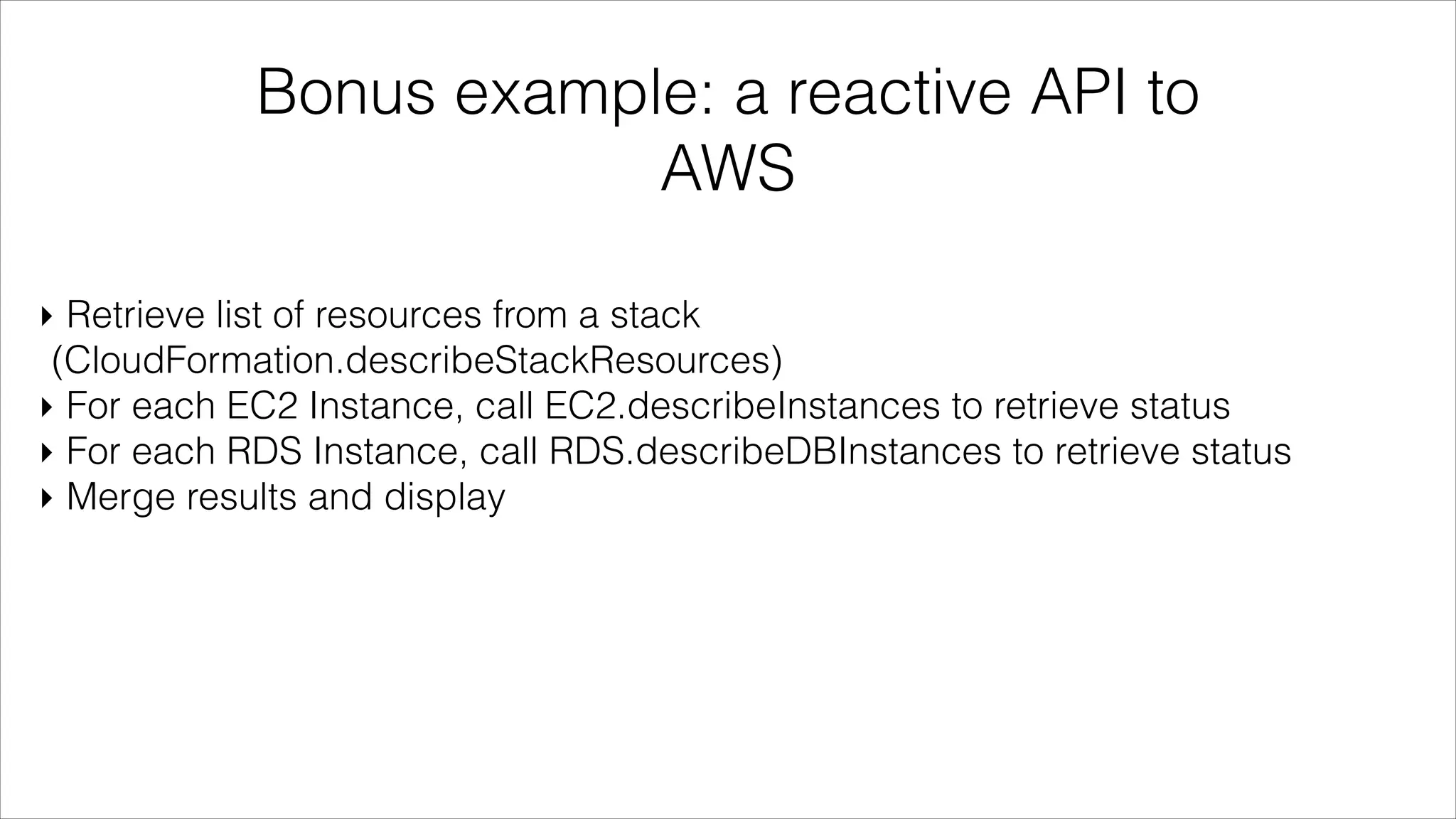
![Step 1: turn api calls into streams (defn resources-stream [stack-name]! (.create js/Rx.Observable! (fn [observer]! (.describeStackResources js/cloudFormation #js {"StackName" : stackName}! (fn [err data]! (if err! (.onError observer err)! (doseq [resource data]! (.onNext observer resource))! (.onCompleted observer)))! (fn [] (.log js/console "Disposed")))))](https://image.slidesharecdn.com/frp-ces-euroclojure-2014-140627053504-phpapp01/75/Functional-Reactive-Programming-Compositional-Event-Systems-65-2048.jpg)
![Step 1: turn api calls into streams (defn ec2-instance-stream [resource-ids]! (.create js/Rx.Observable! (fn [observer]! (.describeInstaces js/ec2 #js {"InstanceIds" resource-ids}! (fn [err data]! (if err! (.onError observer err)! (doseq [instance data]! (.onNext observer instance)))! (.onCompleted observer)))! (fn [] (.log js/console "Disposed")))))!](https://image.slidesharecdn.com/frp-ces-euroclojure-2014-140627053504-phpapp01/75/Functional-Reactive-Programming-Compositional-Event-Systems-66-2048.jpg)
![Step 1: turn api calls into streams (defn rds-instance-stream [resource-id]! (.create js/Rx.Observable! (fn [observer]! (.describeDBInstances js/rds #js {"DBInstanceIdentifier" resource-id}! (fn [err data]! (if err! (.onError observer err)! (.onNext observer data))! (.onCompleted observer)))! (fn [] (.log js/console "Disposed")))))](https://image.slidesharecdn.com/frp-ces-euroclojure-2014-140627053504-phpapp01/75/Functional-Reactive-Programming-Compositional-Event-Systems-67-2048.jpg)
![Step 2: transform the different API responses into a common output (def resources (resourcesStream "my-stack"))! ! (def ec2-data (-> resources! (.filter ec2?)! (.map :resource-id)! (.flatMap ec2-instance-stream)! (.map (fn [data] {:instance-id ...! :status ...}))))! ! (def rds-data (-> resources! (.filter rds?)! (.map :resource-id)! (.flatMap rds-instance-stream)! (.map (fn [data] {:instance-id ...! :status ...}))))!](https://image.slidesharecdn.com/frp-ces-euroclojure-2014-140627053504-phpapp01/75/Functional-Reactive-Programming-Compositional-Event-Systems-68-2048.jpg)
![Step 3: merge results and update UI (-> ec2-data! (.merge rds-data)! (.reduce conj [])! (.subscribe (fn [data] (update-interface ...))))](https://image.slidesharecdn.com/frp-ces-euroclojure-2014-140627053504-phpapp01/75/Functional-Reactive-Programming-Compositional-Event-Systems-69-2048.jpg)

